Sir John Monash, Personal Files Book 16, 9 October - 31 October 1917, Part 1
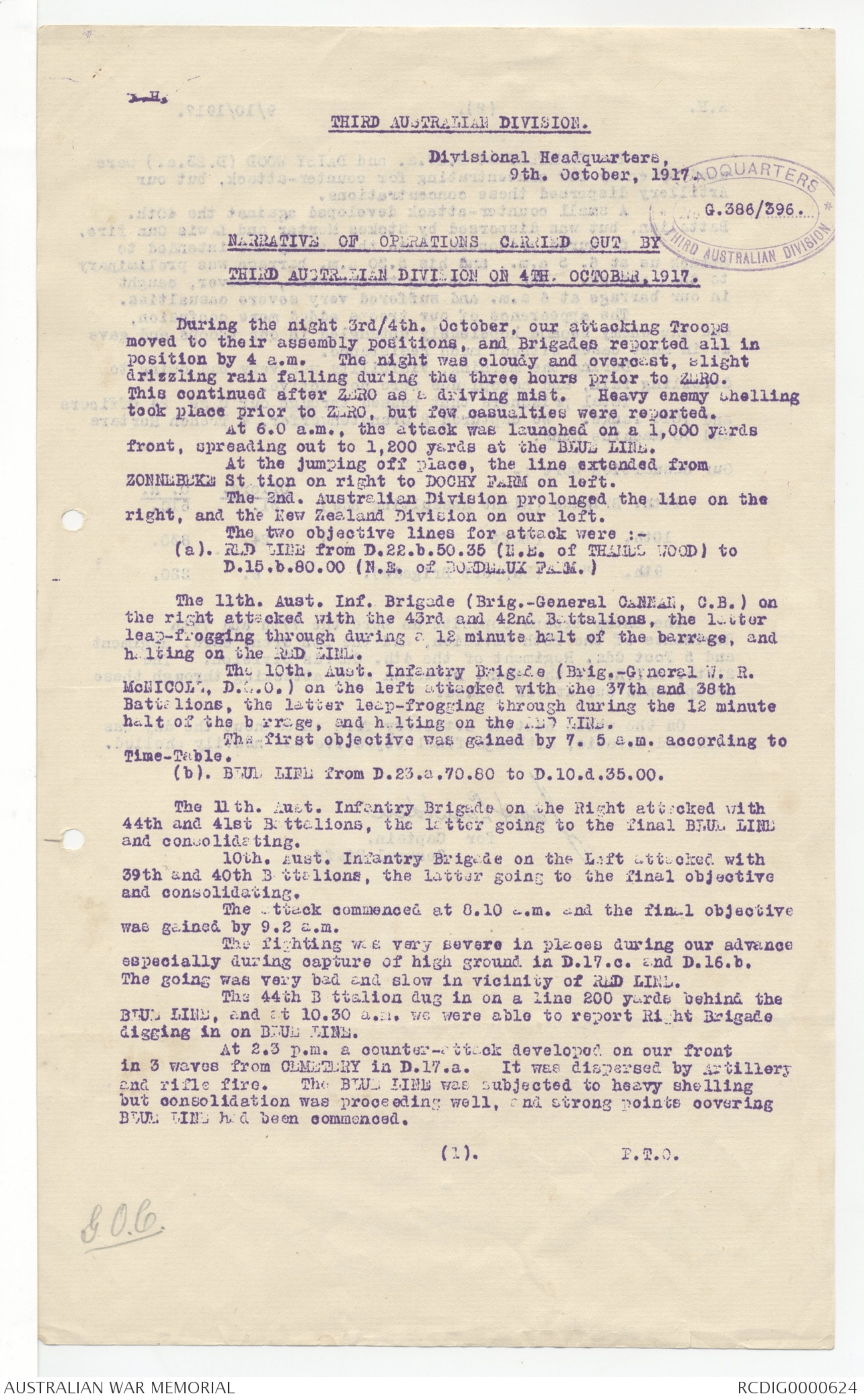
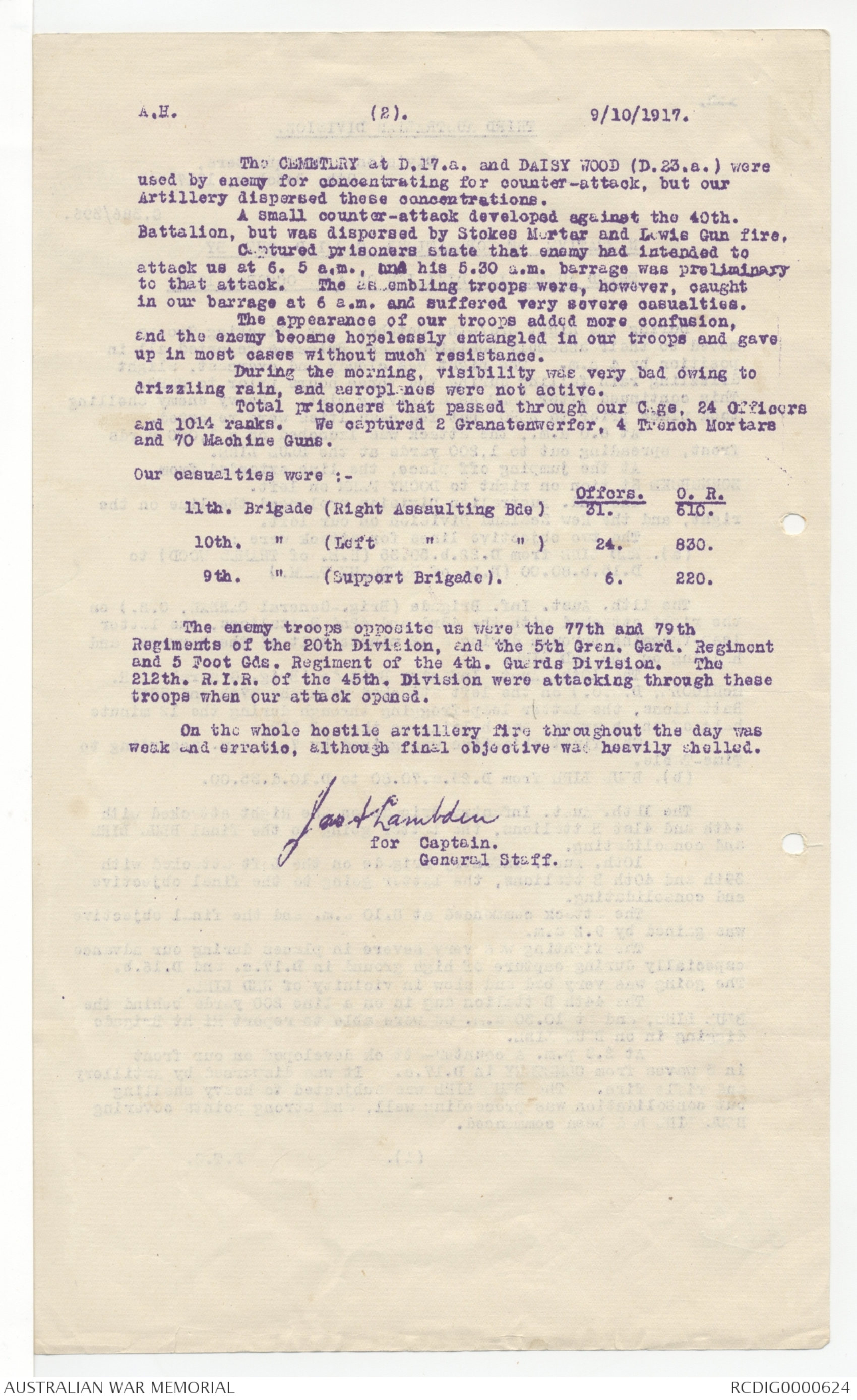
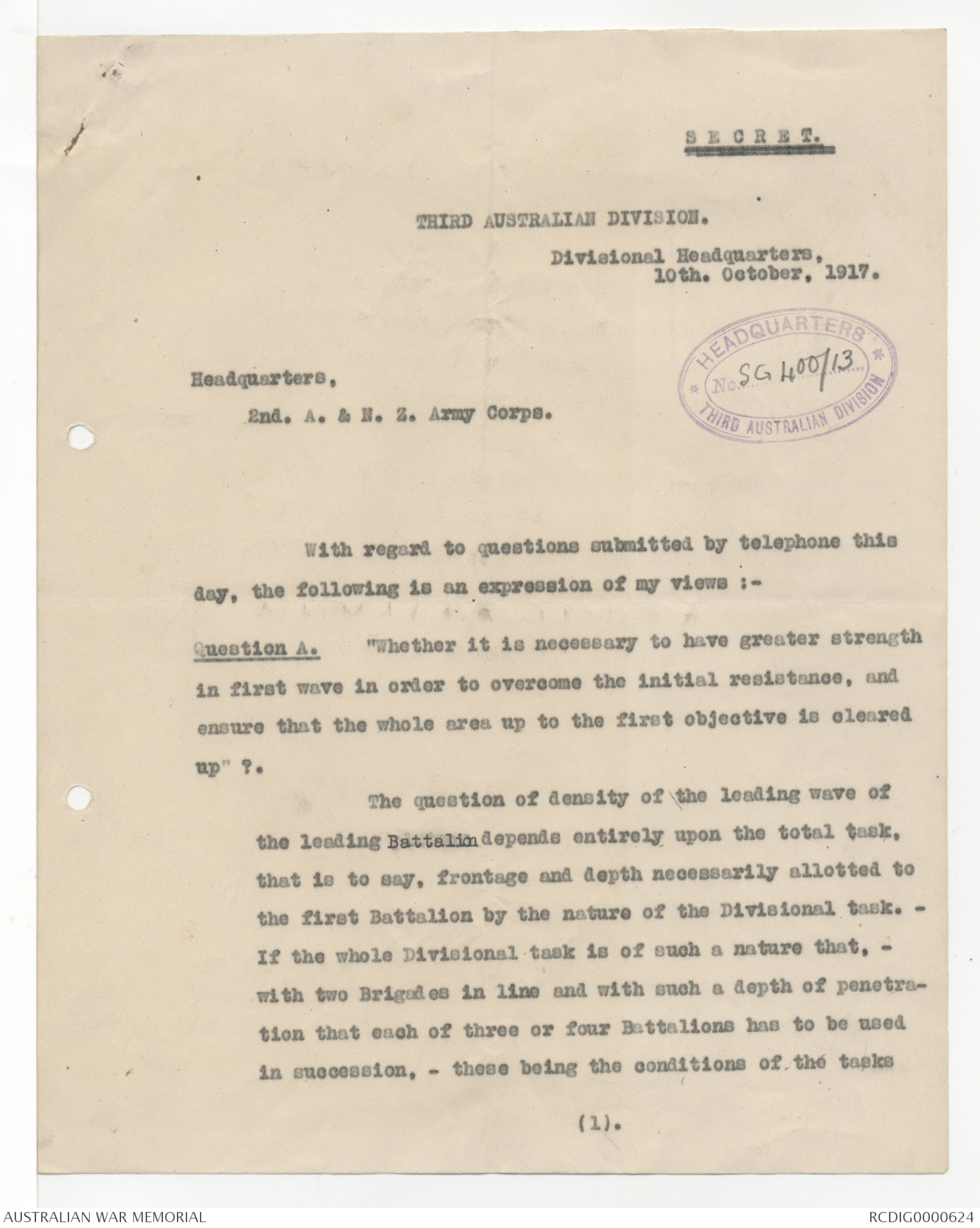
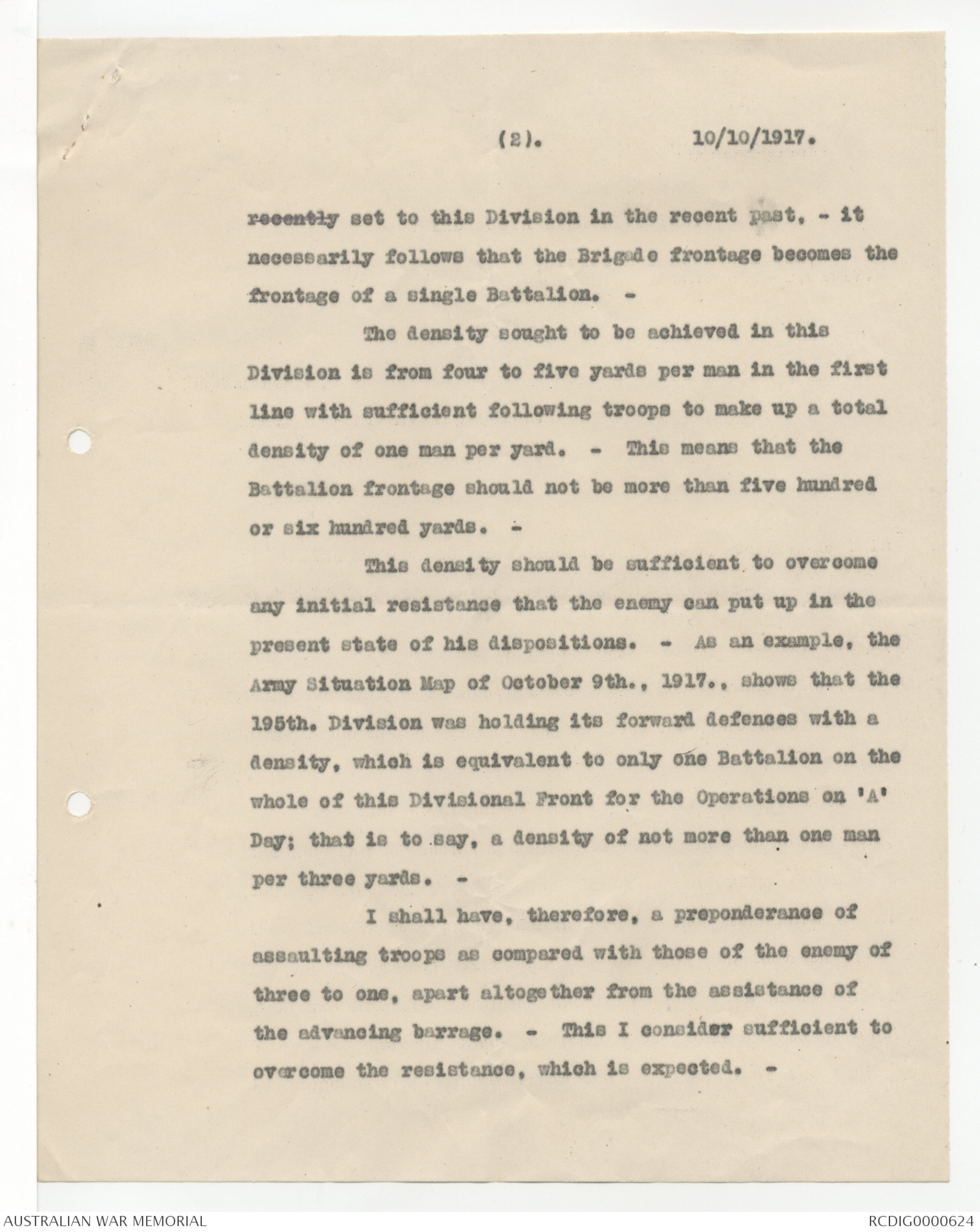
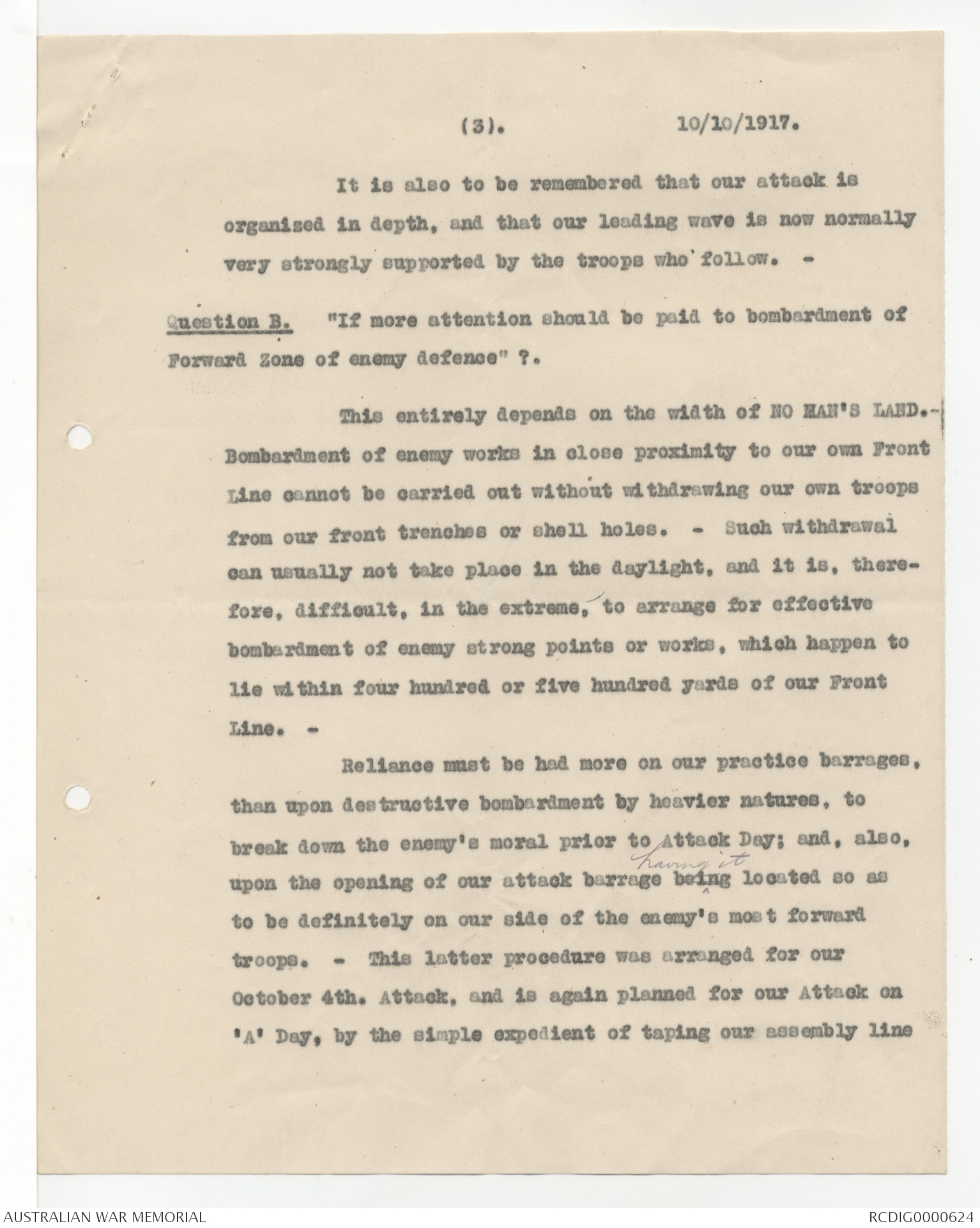

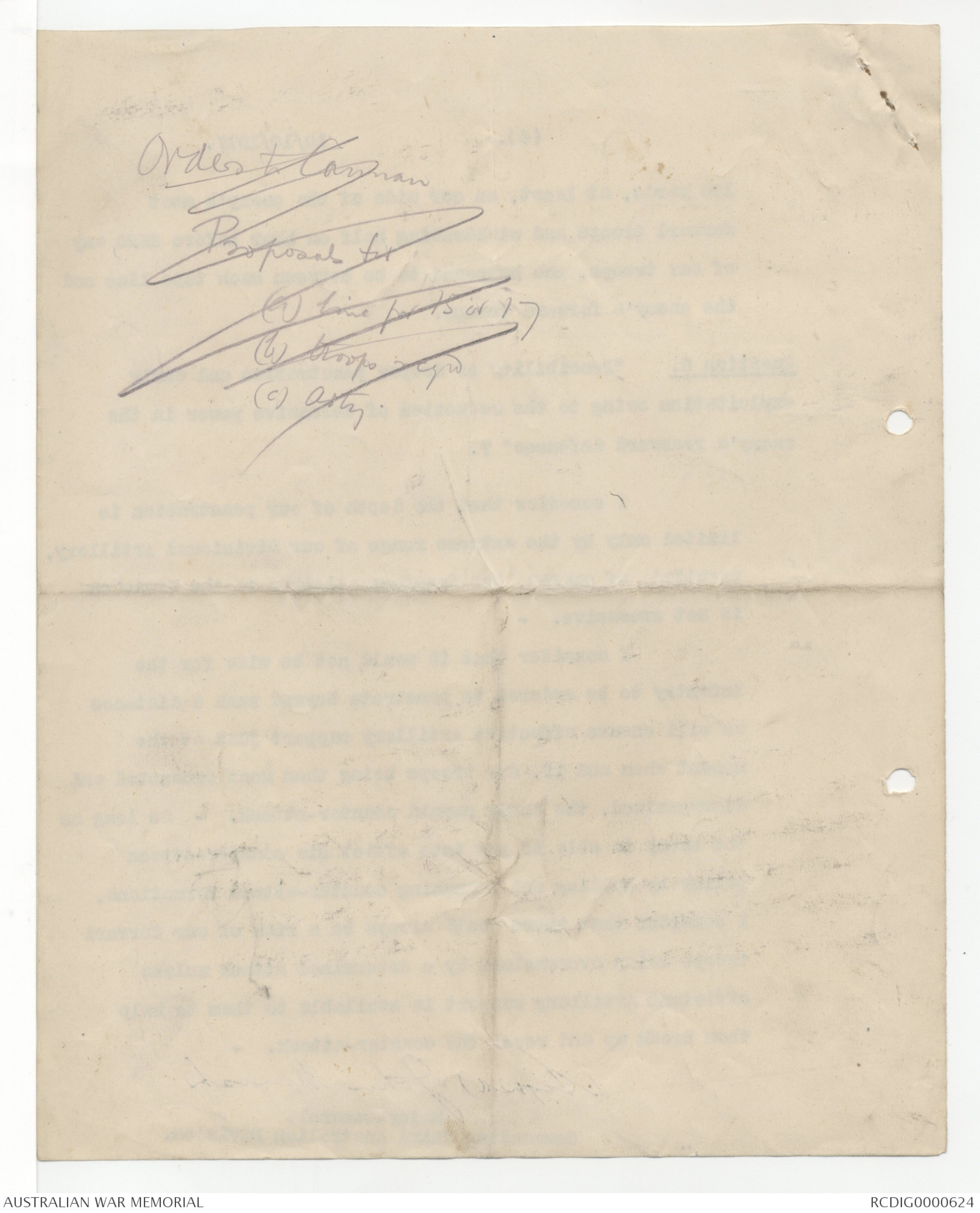
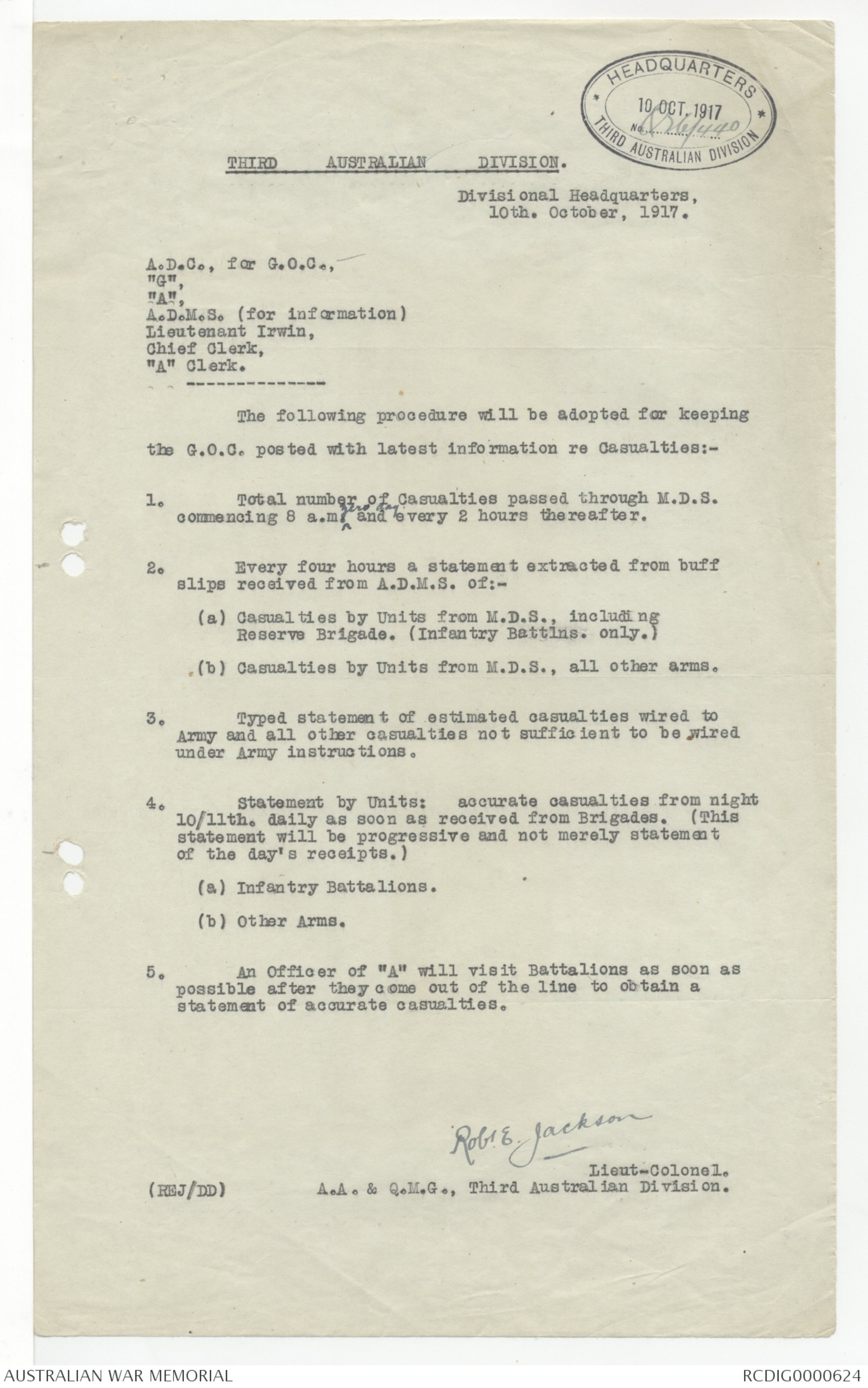
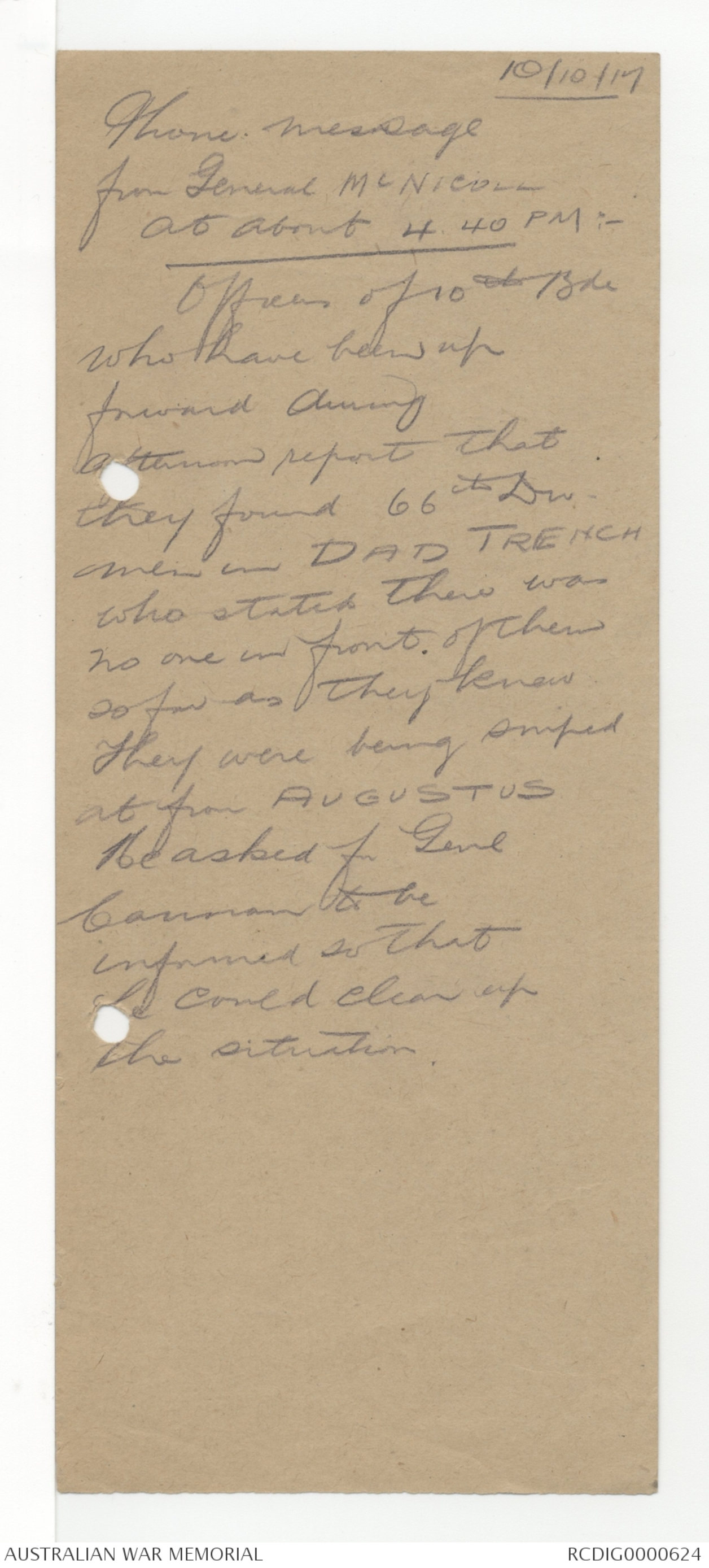
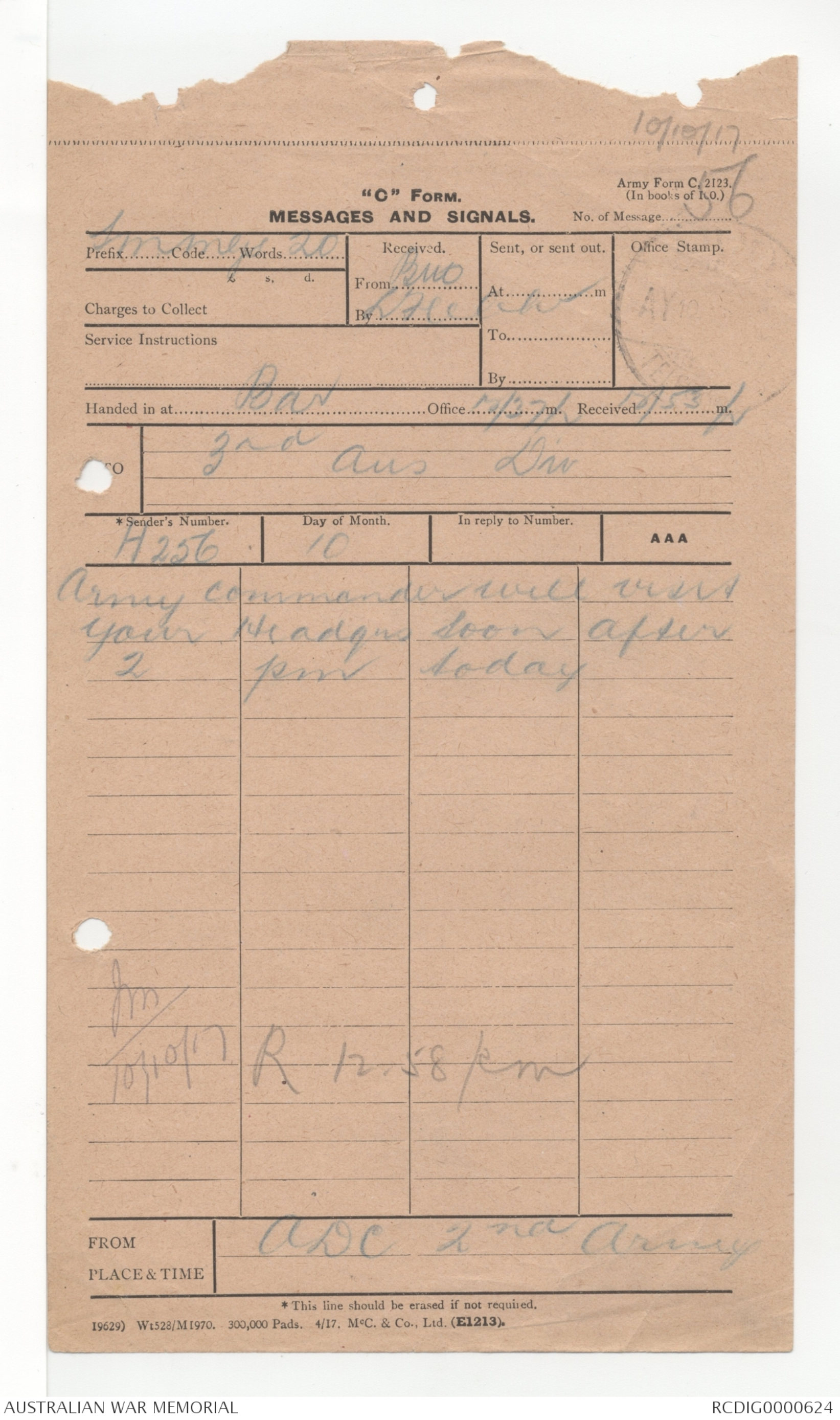
THIRD AUSTRALIAN DIVISION.
Divisional Headquarters,
9th. October, 1917.
HEADQUARTERS
G.386/396.
THIRD AUSTRALIAN DIVISION
NARRATIVE OF OPERATIONS CARRIED OUT BY
THIRD AUSTRALIAN DIVISION ON 4TH OCTOBER, 1917.
During the night 3rd/4th. October, our attacking Troops
moved to their assembly positions, and Brigades reported all in
position by 4 a.m. The night was cloudy and overcast, slight
drizzling rain falling during the three hours prior to ZERO.
This continued after ZERO as a driving mist. Heavy enemy shelling
took place prior to ZERO, but few casualties were reported.
At 6.0 a.m., the attack was launched on a 1,000 yards
front, spreading out to 1,200 yards at the BLUE LINE.
At the jumping off place, the line extended from
ZONNEBEKE St tion on right to DOCHY FARM on left.
The 2nd. Australian Division prolonged the line on the
right, and the New Zealand Division on our left.
The two objective lines for attack were:-
(a). RED LINE from D.22.b.50.35 (N. E. of THAMES WOOD) to
D.15.b.80.00 (N.E. of BORDEAUX FARM.)
The 11th. Aust. Inf. Brigade (Brig.-General CANNAN, C.B.) on
the right attacked with the 43rd and 42nd Battalions, the latter
leap-frogging through during a 12 minute halt of the barrage, and
halting on the RED LINE.
The 10th. Aust. Infantry Brigade (Brig.-General W. R.
McNICOLL, D.C.O.) on the left attacked with the 37th and 38th
Battalions, the latter leap-frogging through during the 12 minute
halt of the barrage, and halting on the RED LINE.
The first objective was gained by 7. 5 a.m. according to
Time-Table.
(b). BLUE LINE from D.23.a.70.80 to D.10.d.35.00.
The 11th. Aust. Infantry Brigade on the Right attacked with
44th and 41st Battalions, the latter going to the final BLUE LINE
and consolidating.
10th. Aust. Infantry Brigade on the Left attacked with
39th and 40th Battalions, the latter going to the final objective
and consolidating.
The attack commenced at 8.10 a.m. and the final objective
was gained by 9.2 a.m.
The fighting was very severe in places during our advance
especially during capture of high ground in D.17.c. and D.16.b.
The going was very bad and slow in vicinity of RED LINE.
The 44th B ttalion dug in on a line 200 yards behind the
BLUE LINE, and at 10.30 a.m. we were able to report Right Brigade
digging in on BLUE LINE.
At 2.3 p.m. a counter-attack developod on our front
in 3 waves from CEMETERY in D.17.a. It was dispersed by Artillery
and rifle fire. The BLUE LINE was subjected to heavy shelling
but consolidation was proceeding well, and strong points covering
BLUE LINE been commenced.
(1)
P.T.0.
G.O.C.
A.H.
(2).
9/10/1917.
The CEMETERY at D. 17 .a. and DAISY WOOD (D. 23 .a.) were
used by enemy for concentrating for counter-attack, but our
Artillery dispersed these concentrations.
A small counter-attack developed against the 40th.
Battalion, but was dispersed by Stokes Mortar and Lewis Gun fire.
Captured prisoners state that enemy had intended to
attack us at 6. 5 a.m., and his 5.30 a.m. barrage was preliminary
to that attack. The assembling troops were, however, caught
in our barrage at 6 a.m. and suffered very severe casualties.
The appearance of our troops added more confusion,
and the enemy became hopelessly entangled in our troops and gave
up in most cases without much resistance.
During the morning, visibility was very bad owing to
drizzling rain, and aeroplanes were not active.
Total prisoners that passed through our Cage. 24 Officers
and 1014 ranks.
We captured 2 Granatenwerfer, 4 Trench Mortars
and 70 Machine Guns.
Our casualties were: -
Offcrs. O.R
11th. Brigade (Right Assaulting Bde) 31. 610.
10th. " (Left " ") 24. 830.
9th. " (Support Brigade). 6. 220.
The enemy troops opposite us were the 77th and 79th
Regiments of the 20th Division, and the 5th Gren. Gard. Regiment
and 5 Foot Gds. Regiment of the 4th. Guards Division. The
212th. R.I.R. of the 45th. Division were attacking through these
troops when our attack opened.
On the whole hostile artillery fire throughout the day was
weak and erratic, although final objective was heavily shelled.
James A Lambden
for Captain.
General Staff.
SECRET
THIRD AUSTRALIAN DIVISION.
Divisional Headquarters
1Oth. October, 1917.
HEADQUARTERS
THIRD AUSTRALIAN DIVISION
No SG 400/13
Headquarters,
2nd. A. & N. Z. Army Corps.
With regard to questions submitted by telephone this
day, the following is an expression of my views :-
Question A. "Whether it is necessary to have greater strength
in first wave in order to overcome the initial resistance, and
ensure that the whole area up to the first objective is cleared
up"?.
The question of density of the leading wave of
the leading Battalion depends entirely upon the total task,
that is to say, frontage and depth necessarily allotted to
the first Battalion by the nature of the Divisional task. -
If the whole Divisional task is of such a nature that, -
with two Brigades in line and with such a depth of penetration
that each of three or four Battalions has to be used
in succession, - these being the conditions of the tasks
(1).
(2). 10/10/1917.
recently set to this Division in the recent past, - it
necessarily follows that the Brigade frontage becomes the
frontage of a single Battalion. -
The density sought to be achieved in this
Division is from four to five yards per man in the first
line with sufficient following troops to make up a total
density of one man per yard. - This means that the
Battalion frontage should not be more than five hundred
or six hundred yards. -
This density should be sufficient to overcome
any initial resistance that the enemy can put up in the
present state of his dispositions. - As an example, the
Army Situation Map of October 9th., 1917., shows that the
195th. Division was holding its forward defences with a
density, which is equivalent to only one Battalion on the
whole of this Divisional Front for the Operations on 'A'
Day; that is to say, a density of not more than one man
per three yards.
I shall have, therefore, a preponderance of
assaulting troops as compared with those of the enemy of
three to one, apart altogether from the assistance of
the advancing barrage. - This I consider sufficient to
overcome the resistance, which is expected. -
(3). 10/10/1917.
It is also to be remembered that our attack is
organized in depth, and that our leading wave is now normally
very strongly supported by the troops who follow. -
Question B. "If more attention should be paid to bombardment of
Forward Zone of enemy defence" ?.
This entirely depends on the width of NO MAN'S LAND.
Bombardment of enemy works in close proximity to our own Front
Line cannot be carried out without withdrawing our own troops
from our front trenches or shell holes. - Such withdrawal
can usually not take place in the daylight, and it is, therefore,
difficult, in the extreme, to arrange for effective
bombardment of enemy strong points or works, which happen to
lie within four hundred or five hundred yards of our Front
Line.
Reliance must be had more on our practice barrages,
than upon destructive bombardment by heavier natures, to
break down the enemy's moral prior to Attack Day; and, also,
upon the opening of our attack barrage being located so as
to be definitely on our side of the enemy's most forward
troops. - This latter procedure was arranged for our
October 4th. Attack, and is again planned for our Attack on
'A' Day, by the simple expedient of taping our assembly line
(4). 10/10/1917.
150 yards, at least, on our side of the enemy's most
forward troops and withdrawing half an hour before ZERO, any
of our troops, who happened to be between such tape line and
the enemy's forward troops. -
Question C. "Possibility of deeper penetration and early
exploitation owing to the reduction of defensive power in the
enemy's rearward defences" ?.
I consider that the depth of our penetration is
limited only by the extreme range of our Divisional Artillery.
provided, of course, the frontage allotted to the Division
is not excessive. -
I consider that it would not be wise for the
Infantry to be ordered to penetrate beyond such a distance
as will ensure effective Artillery support just at the
moment when and if, our troops being then most exhausted and
disorganized, the enemy should counter-attack. - So long as
the enemy is able to put into effect his counter-attack
policy by holding and launching counter-attack formations,
I consider that there would always be a risk of our forward
troops being overwhelmed by a determined attack unless
efficient Artillery support is available to them to help
them break up and repel the counter-attack. -
(Signed) John Monash
Major-General.
Commanding Third Australian Division.
Orders to Cannan
Proposals for (a) line for 15 or 17
(b) troops reqd
(c) Arty
HEADQUARTERS THIRD AUSTRALIAN DIVISION.
10 OCT. 1917
No 26/440
THIRD AUSTRALIAN DIVISION.
Divisional Headquarters,
10th. October, 1917.
A.D.C., for G.O.C.,
"G",
"A",
A.D.M.S. (for information)
Lieutenant Irwin,
Chief Clerk,
"A" Clerk.
---------------
The following procedure will be adopted for keeping
the G.O.C. posted with latest information re Casualties:-
1. Total number of Casualties passed through M.D.S.
commencing 8 a.m. ^yesterday and every 2 hours thereafter.
2. Every four hours a statement extracted from buff
slips received from A.D.M.S. of:-
(a) Casualties by Units from M.D.S., including
Reserve Brigade. (Infantry Battlns. only.)
(b) Casualties by Units from M.D.S., all other arms.
3. Typed statement of estimated casualties wired to
Army and all other casualties not sufficient to be wired
under Army instructions.
4. Statement by Units: accurate casualties from night
10/11th. daily as soon as received from Brigades. (This
statement will be progressive and not merely statement
of the day's receipts.)
(a) Infantry Battalions.
(b) Other Arms.
5. An Officer of "A" will visit Battalions as soon as
possible after they come out of the line to obtain a
statement of accurate casualties.
Robt. E. Jackson
Lieut-Colonel.
(REJ/DD) A.A. & Q.M.G., Third Australian Division.
10/10/17
Home message
from General McNICOLL
at about 4.40 PM:-
Officers of 10th Bde
who have been up
forward during
afternoon report that
they found 66th Div
men in DAD TRENCH
who stated there was
no one in front of them
so far as they knew
They were being sniped
at from AUGUSTUS
He asked for Genl
Cannan to be
informed so that
he could clear up
the situation.
10/10/17
Army Form C, 2123.
"C" FORM.
(In books of 100.)
MESSAGES AND SIGNALS.
No. of Message 56
Prefix SManey Code Words 20
£. s. d.
Charges to Collect
Received.
From BNO
By [[?]]
Sent, or sent out
At [[?]] m
To
By
Office Stamp.
Handed in at [[Bar?]] Office 12/37pm. Received 12/53pm.
To 3rd Aus Div
*Sender's Number H256
Day of Month 10
In reply to Number AAA
Army commander will visit
your Headqrs soon after
2 pm today
JM
10/10/17 R 12.58 pm
FROM ADC 2nd Army
PLACE & TIME
 Sam scott
Sam scottThis transcription item is now locked to you for editing. To release the lock either Save your changes or Cancel.
This lock will be automatically released after 60 minutes of inactivity.